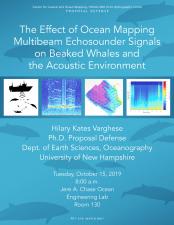The Effect of Ocean Mapping Multibeam Echosounder Signals on Beaked Whales and the Acoustic Environment
Earth Sciences–Oceanography
UNH
Sound can propagate great distances underwater and is an important mode of information for marine life. Many human activities in the ocean intentionally and unintentionally emit sound. Therefore, it is essential that the effects of anthropogenic noise on marine life and the ambient marine environment are understood. Most of the work to date has focused on the impact of low-frequency (<1 kHz) sources such as shipping noise, and mid-frequency (1-10 kHz) sources such as Naval sonar, to which many marine mammals have shown to be sensitive. Less work has focused on higher frequency sources (>10 kHz), such as ocean mapping multibeam echosounder (MBES) signals. However, some marine mammals, including beaked whales, are capable of hearing these higher frequency sources. Without a better understanding of the interaction of high frequency sound with marine mammals, the current guidelines imposed for marine mammal protection may not be protective enough, or alternatively, may be too conservative. With targeted research to assess the effect of ocean mapping sonar on vulnerable marine life and the ambient marine environment, we can begin to understand how this sound source fits in to existing regulation, and/or provide insight for how existing policy should be modified to protect marine mammals from this sound source. Hence, the aim of this research is to contribute to the understanding of potential effects ocean mapping multibeam echosounder (MBES) signals may have on marine life by specifically assessing potential effects of MBES signals on beaked whale foraging and a local acoustic environment.
Hilary received her B.Sc. in the Biological Sciences with distinction in research from Cornell University in 2011, where she studied the evolution of luminescent courtship signals in Caribbean ostracods. After college she moved to Florida to work as a research associate for a biofuel company. Simultaneously, she completed her master’s degree in Applied Mathematics at Florida Gulf University. Hilary is now pursuing her Ph.D. in Oceanography at the University of New Hampshire, where her work focuses on the effect of anthropogenic noise on marine life.





